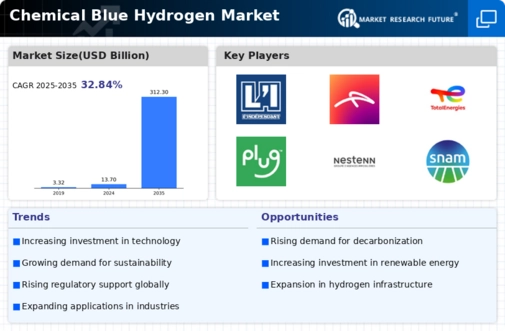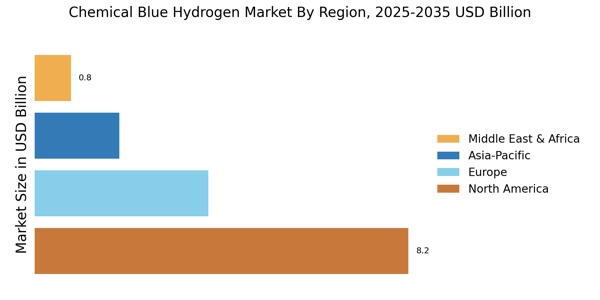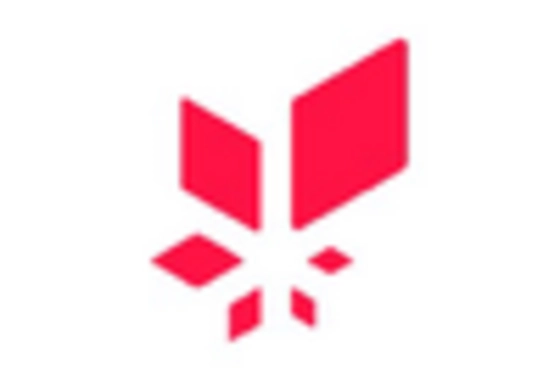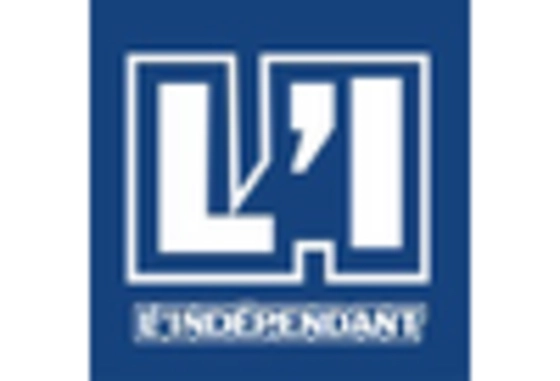Increasing Regulatory Support
The Chemical Blue Hydrogen Market is experiencing a surge in regulatory support aimed at reducing carbon emissions. Governments are implementing policies that favor low-carbon technologies, including blue hydrogen production. For instance, various countries have set ambitious targets for carbon neutrality, which necessitates the adoption of cleaner energy sources. This regulatory environment is likely to enhance investments in blue hydrogen projects, as companies seek to comply with stringent emissions standards. The International Energy Agency has indicated that hydrogen could account for up to 18% of total energy demand by 2050, underscoring the potential for growth in the Chemical Blue Hydrogen Market. As regulations tighten, the demand for blue hydrogen is expected to rise, driving market expansion.
Growing Industrial Applications
The Chemical Blue Hydrogen Market is witnessing an increase in demand from various industrial sectors, particularly in refining and ammonia production. Blue hydrogen serves as a crucial feedstock in these industries, where it is utilized to produce cleaner fuels and fertilizers. The refining sector, for example, is projected to require substantial amounts of hydrogen to meet new environmental standards. According to recent estimates, the hydrogen demand in the refining industry alone could reach 10 million tons annually by 2030. This growing industrial application of blue hydrogen is likely to propel the Chemical Blue Hydrogen Market forward, as companies seek to enhance their sustainability profiles while maintaining operational efficiency.
Investment in Infrastructure Development
The Chemical Blue Hydrogen Market is poised for growth due to increased investment in infrastructure development. The establishment of hydrogen production facilities, storage systems, and distribution networks is critical for the widespread adoption of blue hydrogen. Governments and private entities are recognizing the need for robust infrastructure to support the hydrogen economy. For instance, investments in pipelines and refueling stations are essential for ensuring the efficient transport and utilization of blue hydrogen. It is estimated that infrastructure investments could exceed several billion dollars in the coming years, significantly impacting the Chemical Blue Hydrogen Market. This influx of capital is likely to accelerate the deployment of blue hydrogen technologies and enhance market accessibility.
Advancements in Carbon Capture Technologies
The Chemical Blue Hydrogen Market is benefiting from advancements in carbon capture and storage (CCS) technologies. These innovations are essential for the effective production of blue hydrogen, as they enable the capture of CO2 emissions generated during the hydrogen production process. Recent developments in CCS have improved efficiency and reduced costs, making blue hydrogen a more viable option for energy producers. The potential for capturing up to 90% of CO2 emissions could significantly enhance the attractiveness of blue hydrogen in the energy mix. As CCS technologies continue to evolve, they are likely to play a pivotal role in the growth of the Chemical Blue Hydrogen Market, facilitating a transition towards a more sustainable energy landscape.
Rising Consumer Awareness and Demand for Sustainability
The Chemical Blue Hydrogen Market is increasingly influenced by rising consumer awareness regarding sustainability and environmental impact. As individuals and businesses become more conscious of their carbon footprints, there is a growing demand for cleaner energy solutions. Blue hydrogen, with its lower emissions profile compared to traditional hydrogen production methods, is gaining traction among environmentally conscious consumers. Market surveys indicate that a significant percentage of consumers are willing to pay a premium for products derived from sustainable sources. This shift in consumer behavior is likely to drive demand for blue hydrogen across various sectors, including transportation and energy, thereby propelling the Chemical Blue Hydrogen Market forward.


















Leave a Comment